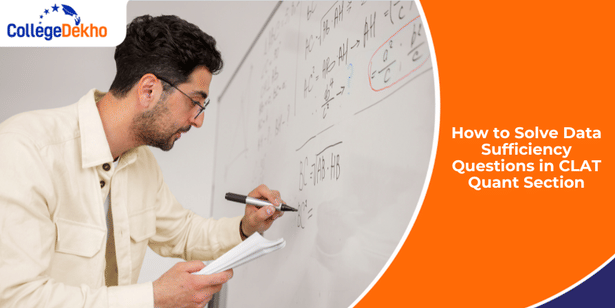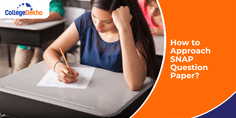
Preparation for the CLAT Quantitative Aptitude section needs up-to-date and smart strategies, and one of the topic areas that can provide you with a special advantage is data sufficiency. In contrast to conventional problem-solving, these questions do not require you to come up with a precise solution. Rather, you need to find out whether the given statements are sufficient to solve the problem. The method allows you to save time with greater accuracy, which is actually necessary in the context of exams. Since CLAT 2026 is likely to contain about 13 to 17 questions in the Quant section, data sufficiency is one area where your performance can be immensely improved. Here is a simple step-by-step explanation on how to approach data sufficiency questions in CLAT Quant section confidently.
Also Read: Tips to Prepare for CLAT Quantitative Techniques Section
What are Data Sufficiency Questions in CLAT 2026?
Data Sufficiency is one of the question types usually encountered in competitive exams like CLAT wherein your task is not to calculate but to determine if the given information is enough to reach an answer. Such question types need logical reasoning and analytical skills. Typically, you are given:
- A main problem statement
- Two separate statements (1) and (2) with information
Your job is to evaluate each statement separately and together. The options usually are:
- (A) Statement 1 alone is sufficient
- (B) Statement 2 alone is sufficient
- (C) Both together are sufficient, not individually
- (D) Each statement is sufficient separately
- (E) Even together, both are not sufficient
How to Approach Data Sufficiency Questions in CLAT 2026 Quant?
To effectively solve data sufficiency questions in the CLAT quant section, follow these simple and efficient steps:
- Read the Question First: Take 20 to 30 seconds to read the question thoroughly and understand what it is asking exactly. Decide if you need a number, a true/ false, or a comparison of variables. This will inform you about what information will answer the question entirely.
- Analyse Each Statement Separately: Start with Statement 1 alone. See if it is sufficient to answer the question. If yes, select option (A). If not, look at Statement 2 and repeat the process; if it is sufficient by itself, select (B).
- Use Both Statements Together If Necessary: Use both of them together if individually each is not sufficient. If together they give a solution, then mark (C). If even together they are insufficient, then mark (E). Remember, if both individually give solutions, the correct answer is (D).
- Avoid assumptions: Make use of the given data and avoid any other assumptions. For example, never assume numbers to be positive without a clear mention since this can mislead your conclusions.
- Be Logical and Systematic: Concentrate on the logic of statements and not on intricate calculations. For example, x−y=5 alone determines "Is x>y?" questions, whereas y>0 alone does not necessarily determine them.
Tips to Improve Efficiency for CLAT 2026 Data Sufficiency Questions
While preparing for CLAT 2026 , problem-solving habits can contribute significantly to your speed and accuracy. Instead of getting excited to solve the entire question, make a habit of simply checking quickly if the given data is sufficient. It saves time and reduces errors. To fine-tune your approach to solving data sufficiency questions under the CLAT quant section, follow these tips:- Recall the answer choices, as this makes you identify sufficiency quicker.
- Practice CLAT previous year papers and provide regular mock tests to be aware of exam patterns.
- In Yes/ No questions, ensure that your argument strongly inclines towards "yes" or "no."
- Do not waste time solving a question completely once sufficiency is evident.
- Schedule time planning and abandon the question if one senses a question is too long.
Common Mistakes to Avoid While Solving Data Sufficiency Questions in CLAT
When preparing for data sufficiency or logical reasoning questions, the majority of aspirants make errors that can undermine both speed and accuracy. To lead, you should avoid these common errors that are predominant in the CLAT exam:
- Making conclusions without properly analysing the statements given.
- Introducing assumptions that aren't implied in the question.
- Forgetting that, at times, both statements have to be reconciled for them to be adequate.
- Confusing checking for sufficiency with fully solving the problem.
- Taking too long with one hard question derails the overall time balance.
Regular practice of data sufficiency questions enhances logical thinking and quick decision-making skills needed for the CLAT 2026 Quant section, where time is short. Rather than calculative efforts, focus on the individual and combined reasoning of the statements. Be logical, don't make assumptions, and follow a systematic approach to gain speed and accuracy under pressure.
Related Reads:
Are you feeling lost and unsure about what career path to take after completing 12th standard?
Say goodbye to confusion and hello to a bright future!

FAQs
Data sufficiency questions in CLAT quant ask you to decide if the given information is enough to solve a problem, not to actually solve it. You get a question and two statements. You check if statement 1 alone, statement 2 alone, or both combined can answer the question. This tests your reasoning and ability to analyse data quickly.
To approach data sufficiency questions in CLAT, first understand what the question asks without solving it completely. Then analyse each statement separately to check if it alone can answer the question. If not, combine both statements to see if together they are sufficient. Avoid assumptions and manage time well during the test.
To know if a statement alone is sufficient in data sufficiency, check if it lets you find a single clear answer to the question. If you can solve the problem fully with just that statement, it is sufficient. Otherwise, it is not. Remember, sufficiency means you can answer without needing extra info, not just partially solving it.
In CLAT, data sufficiency questions usually ask if the given statements provide enough information to answer a problem. Common types include:
- Quantitative questions (math-based, like ratios, percentages, equations)
- Logical reasoning questions (sequences, relations, codes)
- Questions with two statements where you decide if one or both are sufficient separately or together
To avoid assumptions in data sufficiency questions, focus only on the information provided in the question and statements. Read the question carefully to understand what is asked. Evaluate each statement individually before combining, and never add extra information or assume conditions not given. Stay objective, analyse all scenarios, and rely strictly on the given data to determine sufficiency.
Was this article helpful?





















Similar Articles
Expected rank for 50 marks in SLAT 2026
What is a Good Score in SLAT 2026?
Government Jobs after LLB
How are SLAT Scores calculated? Marking Scheme explained
What is the Required CLAT 2026 Rank for NUSRL Ranchi Admission?
What is the Required CLAT 2026 Rank for HNLU Raipur Admission?